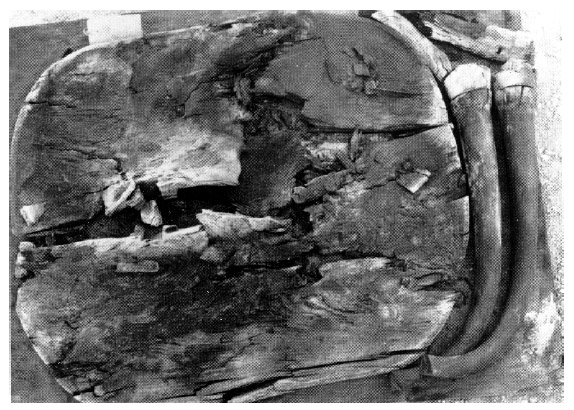ALVAR AND BUTVAR: THE USE OF POLYVINYL ACETAL RESINS FOR THE TREATMENT OF THE WOODEN ARTIFACTS FROM GORDION, TURKEYKRYSIA E. SPIRYDOWICZ, ELIZABETH SIMPSON, ROBERT A. BLANCHETTE, ARNO P. SCHNIEWIND, MAURAY K. TOUTLOFF, & ALISON MURRAY
2 BRIEF HISTORY OF THE TREATMENT OF DRY ARCHAEOLOGICAL WOODA relatively large body of literature now exists concerning the treatment of waterlogged wood from archaeological sources. However, the number of publications dealing with the treatment of dry archaeological wood remains small. During the 1960s and 1970s, thermosetting synthetic resins such as epoxies and polyesters were proposed for the consolidation of degraded wooden artifacts and structures (for example, Schaffer 1971, 1974; Munnikendam and Wolschrijn 1969). However, their significant disadvantages, including lack of reversibility, unsatisfactory surface appearance, and the difficulty of control during curing (Schaffer 1971; Munnikendam 1978; Grattan 1980), were soon recognized, which led to the search for more suitable alternatives. Soluble thermoplastic resins appeared to offer a number of significant advantages over thermosetting resins. In 1980, Grattan examined a number of commercially available thermoplastic resins and found polyvinyl butyral and various acrylic resins to be the most promising consolidants (Grattan 1980). In the following year, Barclay (1981) employed polyvinyl butyral to successfully consolidate a wooden fire engine dating to the 18th century. Barclay's results influenced Robert Payton, the first conservator for the Gordion Furniture Project, to consider the use of polyvinyl butyral as a potential consolidant for the ancient wood. However, Payton selected Butvar B-98 for testing rather than Butvar B-90, the grade used by Barclay. Payton deliberately chose to experiment with the grade of resin that offered the lowest molecular weight and lowest viscosity in solution in order to promote the highest degree of penetration. When tests confirmed the suitability of Butvar B-98, Payton used it to consolidate an ornate inlaid table from Tumulus MM (Payton 1984a). The treatment originated by Payton was further developed and refined by an international group of conservators in subsequent seasons to successfully treat all of the ancient wooden furniture found in the three great early tumuli at Gordion (Spirydowicz 1996; Simpson and Spirydowicz 1999). During the mid-1980s, scientific testing of thermoplastic resins was proceeding. In 1985, Wang and Schniewind evaluated improvements in strength and stiffness in samples of bacterially degraded wood after treatment with a variety of consolidants, including polyvinyl butyral, Paraloid B-72, and polyvinyl acetate resins (Wang and Schniewind 1985). This work was followed by an assessment of the adhesive qualities of thermoplastic resins used as consolidants (Sakuno and Schniewind 1990) and, in the same year, by an analysis of the effects of solvent retention after consolidation with thermoplastic resins (Carlson and Schniewind 1990). Scanning electron microscopy was used to study the distribution of synthetic resin consolidants in samples of degraded wood (Schniewind and Eastman 1994) as well as to evaluate changes caused by the introduction and subsequent extraction of consolidants (paraffin wax
Over the past 30 years, the deterioration of archaeological wood has been more fully characterized. In a comprehensive study of samples of ancient wood recovered from Egyptian tombs and areas along the Nile Valley, Blanchette utilized transmission electron microscopy to reveal stages of decay at the cellular level as well as to identify biological and chemical agents of degradation (Blanchette et al. 1994). This followed earlier studies conducted by Blanchette and others, including an overview of the microbial deterioration of wood with reference to archaeological samples (Blanchette et al. 1990) and an examination of the log coffin from Tumulus MM at Gordion (Blanchette and Simpson 1992). |
